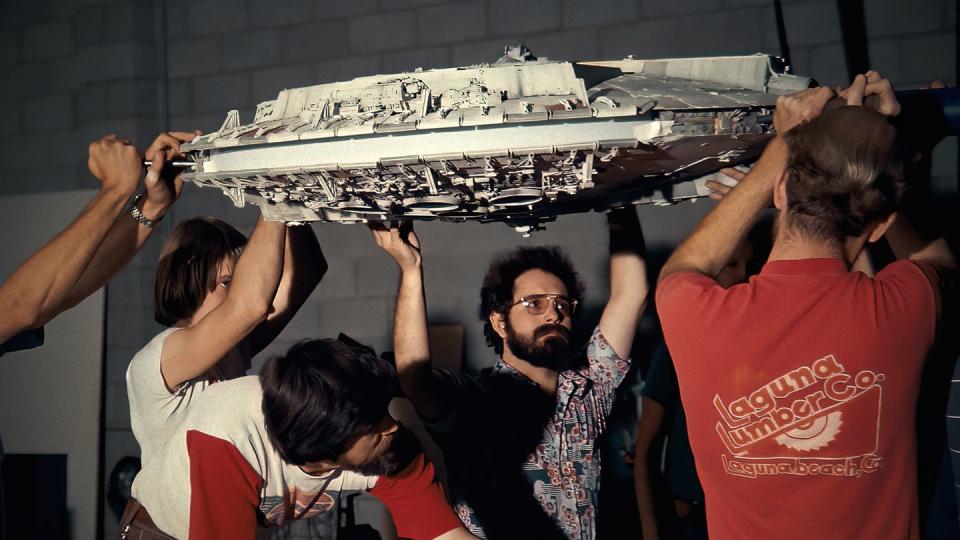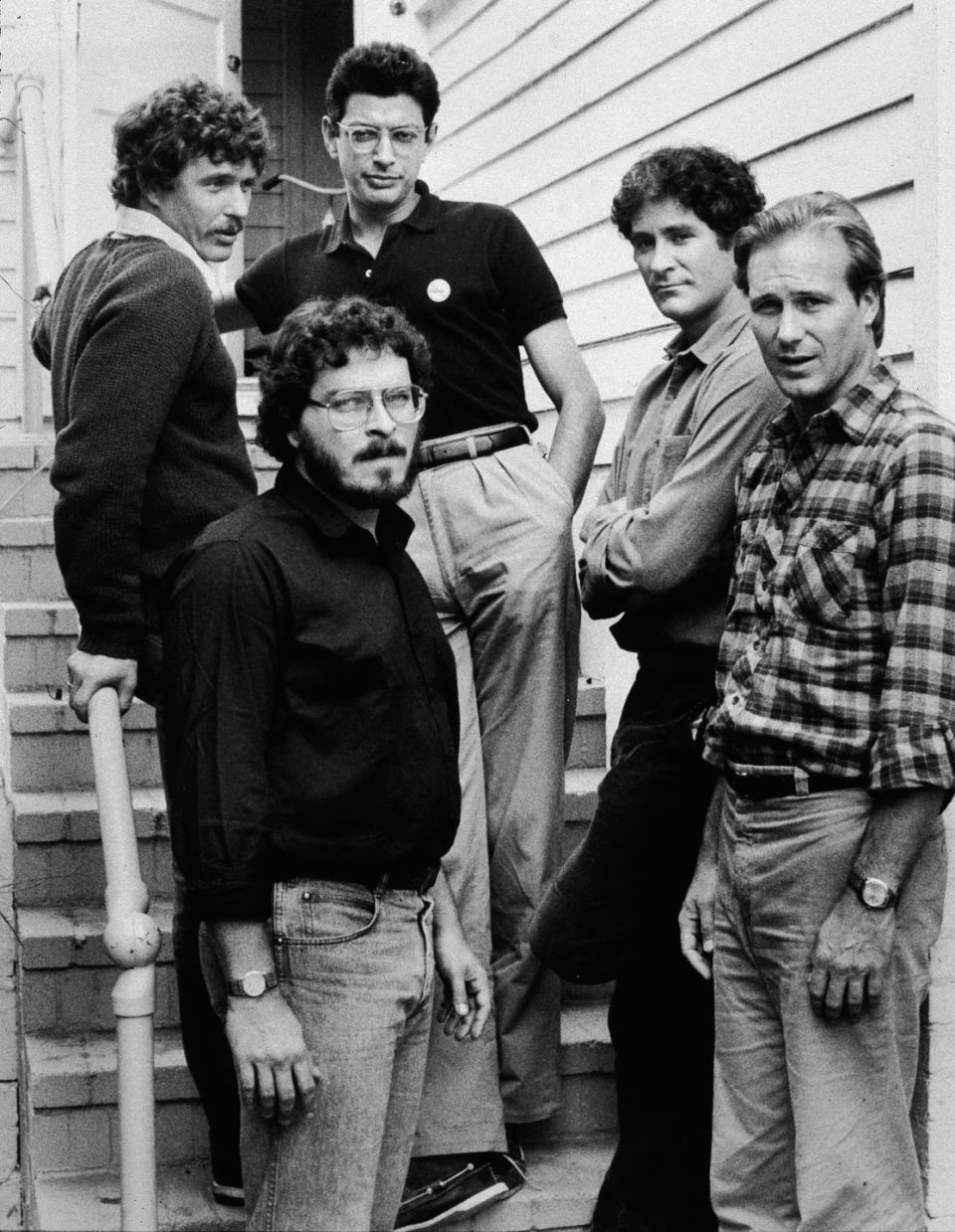Lawrence Kasdan Has the Best Job in Galaxies Near and Far, Far Away
- Oops!Something went wrong.Please try again later.
- Oops!Something went wrong.Please try again later.
"Hearst Magazines and Yahoo may earn commission or revenue on some items through the links below."
Oh, to be a fly on the wall at a moment of great creative expression—the writer’s room of Your Show of Shows in the ’50s, the recording studios of Muscle Shoals in the ’60s, or even the design studios of Industrial Light & Magic (ILM) in the ’70s. ILM, of course, is the visual effects powerhouse that—through its work on films such as Star Wars, E.T., and Back to the Future—changed the way we make, think about, and watch movies.
ILM is the subject of Light & Magic, a six-part docuseries now streaming on Disney+, directed by Lawrence Kasdan. With access to a wealth of material, Kasdan, an industry legend new to documentaries, tells the tale of ILM—where necessity was the mother of invention. It’s a story about how an unlikely group of talented, incredibly smart misfits changed Hollywood forever. The early episodes focus on the creation of the company and the original Star Wars movie, while the later episodes cover the digital revolution, particularly the game-changing impact of Jurassic Park.
Kasdan is no bystander to how George Lucas and his sometimes collaborator, Steven Spielberg, altered the world. After all, Kasdan wrote the screenplays for Raiders of the Lost Ark, The Empire Strikes Back, and Return of the Jedi—not to mention The Force Awakens and Solo: A Star Wars Story. Yet his own career as an accomplished a writer-director has not relied on special effects, but on character and story, evident in Kasdan’s most famous works: Body Heat, The Big Chill, The Accidental Tourist, and Grand Canyon. Kasdan writes great lead characters as well as ensemble films, but he’s also a throwback to the screenwriters of the old studio system who can write memorable small parts—think Mickey Rourke and Ted Danson in Body Heat.
That said, leave it to Kasdan to be interested chiefly in the people behind the effects at ILM, rather than the effects themselves. Which isn’t to say he’s indifferent to the wonders of visual wizardry. If Kasdan is animated to document the characters behind ILM, he’s also still a kid, enthralled by movie magic, wondering one thing: How did they do that?
This conversation has been edited and condensed for clarity.
ESQ: I read that you recently made a different documentary with your wife Meg, who has also been a longtime collaborator in various regards. How did that come about?
Lawrence Kasdan: It’s absolutely relevant to this conversation. I had never made a documentary. My wife Meg and I would eat at this little diner on Robertson and Melrose here in L.A. once or twice a week. Unexpectedly one day, the owner, who we knew and liked, announced that she was going to sell the place. Like a lot of regulars, we were shocked and when we got home that day, Meg said, “You know, she should make a movie about the last week.” It’s a 40-minute documentary and it’s about the last week they were open. We started right away and put it together before they closed. I loved doing it, I loved doing it with Meg, I loved having the people say things that I had not written. They said much better stuff in real life.
What I found intriguing about the ILM team is that it combined science and mechanics with artistry.
You put your finger on why I did this show. I had interest in the technological side of it and had been around it for 40 years and had made some movies with effects, but I didn’t know much about it. The reason I didn’t know a lot about the details is because that’s not what interested me. What interested me is: Who are the people who come up with this stuff? And, when they are presented with a problem from some other genius like Steven Spielberg or [James] Cameron, who are saying, “Help me, I have this thing in my head, but I don’t even know if it should like that. You guys, listen to what I’m thinking and tell me what I should do.” That coming together, that’s what interests me the most. People of various talents, putting their full force to work.
The first two episodes are about how John Dykstra assembled a motley crew to do the effects for Star Wars. There was no template for what they were attempting to do.
Well, everybody’s life has a lot to do with luck, and not getting lucky, and who did you meet, who did you run into. and what school did you go to where you met someone who became your best friend? It’s just chance. It was chance that I went to Michigan. I mean, I wanted to go there but I didn’t know if I could get in. They had this amazing playwriting teacher and I went there for that express purpose. It was chance that when George Lucas and Gary Kurtz were looking for somebody [to do special effects on Star Wars], for a company that didn’t exist or didn’t know if it should exist.

Ed Catmull, who came to ILM to do computer graphics, has a great line about how inspiring it was to work with people who are essentially problem solvers. How when you admit you don’t know the answer, it brings you together in a kind of egoless way.
You know, I always thought that directing movies is the best job on earth. What is so attractive about it is that you get to do all these things at once. And if you’re written them too, you’ve created the problems. And then what happens from the moment someone says, yes, we’ll make that screenplay into a movie, then hordes of people come to you who have been training their whole life to be good at what they do. Even if what they do is find locations. They know how to get the street traffic to stop when you need it to. And they know how to decorate a room. And they know how to put a library in a room where they have to find thousands of books. And you’re not going to shoot in a real library but on some set. And they not only have to bring in the books, they have to make them look like they’ve always been there. That’s a separate skill.
And you are always making decisions in the editing room. In The Big Chill, Kevin Costner’s part was cut completely, with the exception of one close-up of his wrists. Was that a situation where you discovered what you had shot just wasn’t working?
Absolutely. He was the star of the flashback, which came at the end of the movie. When we put the movie together, we realized that the flashback not only wasn’t adding, it was actually subtracting. People were now confused about the previous hour and a half. If you took it out, they weren’t confused at all. This happens all the time when you’re making movies. You’re sitting in an editing room for six months saying, this has to be this way, that has to be that way and then somebody says, you know, I don’t think you need that. And you go, "Oh, you’re crazy, I know I need it. Cause I have the grand scheme in my head. But I’ll try it.” And it goes out and suddenly you feel lighter and happier because you’ve been living with this thing that didn’t have to be there.
Is it just something you feel? There is a memorable sequence with Dennis Muran in the docuseries where he is trying to find a solution to a problem and before he cognitively understood what to do, he says that his body was telling him. He felt it.
I love that part. And Dennis, you know, he’s like Albert Einstein. He’s the big brain. I love the way he talks about it. Because he’s talking about breakthroughs that he made that changed the world. He was that important. But you have to go further back to what George said to him. George didn’t say you’ve got to have an answer by five o’clock tonight. He said, “Just think about it.” And when he gave them that space and that license, they did extraordinary things.
The first few episodes of the show was about the formation of ILM and its early projects. As the series goes on, however, the major storyline is the emergence of digital technology. Muran was one of the old-school heads who embraced the new technology. Even though there was much resistance—at ILM and the industry as a whole—Lucas understood this is where we were headed.
A lot of people resisted because digital was so foreign to them. When you get to be my age, things amaze you every day. You say, really, can the world come to that? It’s a bad thing. It’s a good thing. But what you realize is you were stuck in your thinking because you’ve spent a lifetime thinking a certain way. The fact that ILM was able to adapt—some could, and some couldn’t—to digital that’s happening everywhere in every walk of life. That’s the question: Do you adapt?
Back to The Big Chill for a moment. The soundtrack to that movie had a life of its own. It was a seminal compilation album of its time. How involved were you in the music?
I was very involved because I asked my wife Meg to supervise it. She was the music supervisor, and she was giving me tons of material. Almost all of it was music she and I had enjoyed at Michigan in the ’60s. It was very personal. She did an amazing job. So we had a lot of things to choose from. We didn’t know if we could pay for it, but it was cheaper then.

That was my other question. How did you afford all of them?
That was probably the last time it was reasonably priced.
The Stones song [“You Can’t Always Get What You Want"] alone.
A few years later and that would have been bigger than the budget for the whole movie. But we got it at the right moment. George had done the same thing with American Graffiti, and it was very powerful. Carol Littleton, who was the editor on most of my movies, is very musical herself. She’s a musician. And we’d try songs in different places, and she’d cut to one of those songs. And once someone like Carol Littleton has cut to a song you already love and you’ve made the images, imagine what that’s like?
I remember the soundtrack did so well you released a second album.
The second one there were only a few songs from the movie, and they filled the rest in. And there were a couple of groups who didn’t want to have their song on the first album—
There’s no Creedence Clearwater Revival.
Yeah. When the first album took off some of the people who originally turned us down said you can put us on the second album. The first album by now has sold seven million copies.
Really, it’s one more incredible thing George Lucas did. He changed everything. I didn’t know, when I first saw Graffiti, that he was going to have such an enormous effect on me and on film. But I knew I loved Graffiti, I knew that movie blew my mind. When you think about it, George thought they should do a soundtrack; George thought of digital editing and digital projection. The guy is amazing.
You Might Also Like

